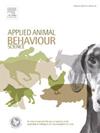An exploration of the postural, location- and social contact- related sub-characteristics of inactive but awake behaviour as a depression-like indicator in mice
IF 2.2
2区 农林科学
Q1 AGRICULTURE, DAIRY & ANIMAL SCIENCE
引用次数: 0
Abstract
Inactive behaviour is essential to life. However, specific forms of inactivity may be indicative of compromised welfare in certain captive conditions. Inactive but awake behaviour (IBA - spontaneous, motionless awake behaviour without interacting with the surroundings) has been documented in some species and may be associated with poor welfare and negatively valenced affective states. In our previous work in laboratory mice, we have identified environmental risk factors (non-enriched housing) and curative factors (antidepressant drug Venlafaxine) for IBA and we hypothesise that greater levels of IBA may represent a depression-like state in this species. Here we aimed to identify which specific sub-characteristics of IBA would show construct validity as a depression-like state by exploring the posture (i.e. lying, curled lying or sitting), social contact position (i.e. in physical contact with a cage mate or not) and location of mice while performing the behaviour during two experiments (respectively investigating the aetiology and the curative factors of IBA). In both experiments we expected that more IBA would be displayed in standard (non-enriched) laboratory cages, compared with large highly-enriched cages and that a move from a highly-enriched to a non-enriched cage would increase IBA, while the opposite treatment would result in a decrease. In our second experiment (curative factors investigation), we predicted that less IBA would be displayed by mice that voluntarily ingested an antidepressant (Venlafaxine) versus a placebo. Because we could not control the number of instances of each IBA sub-characteristic we measured and we had no a priori predictions about which IBA sub-characteristics would match our general IBA treatment predictions, we compared the effect size and the direction of the effect between our treatment groups to explore which of the sub-characteristics matched our general IBA predictions. Overall, we found little variation in the location IBA was performed, with the majority being seen in the nest. Across treatment comparisons in both experiments, overall, the largest effect sizes were measured for IBA performed when in contact with the cage mate and performed when lying and both characteristics generally matched the direction of our treatment-related predictions. We suggest that future work should perform more detailed analyses of the specific characteristics of IBA by identifying behavioural sequences and the co-occurrence of the sub-characteristics to obtain a more complete picture of IBA as a depression-like indicator.
探索作为小鼠抑郁样指标的不活跃但清醒行为的姿势、位置和社会接触相关子特征
不活动是生命的基本要素。然而,在某些圈养条件下,特定形式的不活动可能表明福利受损。不活跃但清醒的行为(IBA - 不与周围环境互动的自发、一动不动的清醒行为)已在某些物种中得到记录,并可能与福利低下和负面情绪状态有关。在我们以前对实验鼠的研究中,我们已经确定了IBA的环境风险因素(非富集饲养)和治疗因素(抗抑郁药物文拉法辛),我们假设IBA水平越高可能代表该物种的抑郁样状态。在此,我们旨在通过在两个实验(分别研究 IBA 的病因和治疗因素)中探究小鼠的姿势(即躺卧、蜷曲躺卧或坐着)、社会接触位置(即是否与笼中的同伴有身体接触)和小鼠在进行该行为时的位置,来确定 IBA 的哪些特定子特征会显示出抑郁样状态的建构有效性。在这两项实验中,我们预计,与高密度的大型笼子相比,在标准(非高密度)实验室笼子中会出现更多的 IBA 行为,而且从高密度笼子转移到非高密度笼子会增加 IBA 行为,而相反的处理则会减少 IBA 行为。在第二个实验(治疗因素调查)中,我们预测自愿摄入抗抑郁药(文拉法辛)的小鼠相对于安慰剂会表现出较少的 IBA。由于我们无法控制所测量的每个 IBA 子特征的实例数量,而且我们也无法事先预测哪些 IBA 子特征会与我们的一般 IBA 治疗预测相匹配,因此我们比较了治疗组之间的效应大小和效应方向,以探索哪些子特征与我们的一般 IBA 预测相匹配。总体而言,我们发现进行 IBA 的地点差异不大,大多数都在巢中。在两个实验的处理比较中,总体而言,与笼伴接触时和躺卧时进行IBA的效应大小最大,而且这两个特征通常与我们的处理相关预测方向一致。我们建议,未来的工作应该通过识别行为序列和子特征的共同出现,对IBA的具体特征进行更详细的分析,以便更全面地了解IBA作为抑郁样指标的情况。
本文章由计算机程序翻译,如有差异,请以英文原文为准。
求助全文
约1分钟内获得全文
求助全文
来源期刊

Applied Animal Behaviour Science
农林科学-行为科学
CiteScore
4.40
自引率
21.70%
发文量
191
审稿时长
18.1 weeks
期刊介绍:
This journal publishes relevant information on the behaviour of domesticated and utilized animals.
Topics covered include:
-Behaviour of farm, zoo and laboratory animals in relation to animal management and welfare
-Behaviour of companion animals in relation to behavioural problems, for example, in relation to the training of dogs for different purposes, in relation to behavioural problems
-Studies of the behaviour of wild animals when these studies are relevant from an applied perspective, for example in relation to wildlife management, pest management or nature conservation
-Methodological studies within relevant fields
The principal subjects are farm, companion and laboratory animals, including, of course, poultry. The journal also deals with the following animal subjects:
-Those involved in any farming system, e.g. deer, rabbits and fur-bearing animals
-Those in ANY form of confinement, e.g. zoos, safari parks and other forms of display
-Feral animals, and any animal species which impinge on farming operations, e.g. as causes of loss or damage
-Species used for hunting, recreation etc. may also be considered as acceptable subjects in some instances
-Laboratory animals, if the material relates to their behavioural requirements
 求助内容:
求助内容: 应助结果提醒方式:
应助结果提醒方式:


